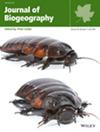Origins and Diversification of the Caatinga Dry Forest Endemic Avifauna
Abstract
Aim
Understanding the geographic origin of lineages is critical to comprehending their biogeographical and evolutionary histories and the historical connections among biomes. In northeastern Brazil, the Caatinga dry forest represents the largest and most biologically diverse patch of Seasonally Dry Tropical Forest in the Neotropics. Here, using the endemic avian taxa of the Caatinga, we aim to (i) infer their biogeographical origins and timing of diversification, (ii) investigate the relationships with taxa from other Neotropical domains and (iii) understand the processes driving the evolution and diversification of the Caatinga endemic avifauna.
Location
Neotropical Region.
Taxon
Birds.
Methods
We obtained previously published calibrated phylogenies of 40 bird species endemic to the Caatinga to reconstruct their ancestral geographic ranges through the R package BioGeoBEARS to infer and highlight the origins, mode and tempo of evolution of the Caatinga avian endemics.
Results
Our results suggest that most avian endemics (21 taxa) are related to lineages from open habitats, including other dry forests or savannas; less than a quarter of the species (9 taxa) likely colonised the Caatinga from adjacent humid forests; we also highlight in situ origins (6 taxa), and cladogenetic events playing an important role in the colonisation of the domain. Although most of the endemics seem to represent new arrivals from adjacent habitats, we also detected relatively old lineages that likely occupied these dry landscapes since the Miocene. A correlation between the age, origins of Caatinga birds and their degree of threat was also found.
Main Conclusions
We provide a much needed framework for the evolution and biogeographic diversification of the Caatinga Dry Forest. The spatio-temporal patterns recovered here suggest an evolutionary history influenced not only by strict vicariance events but also by episodes of dispersal that likely played an important role in the origin of its avifauna. These events were likely influenced by major climatic and geological events that formed ancient corridors, allowing connections between the Caatinga and both dry and humid forests in South America.


 求助内容:
求助内容: 应助结果提醒方式:
应助结果提醒方式:


